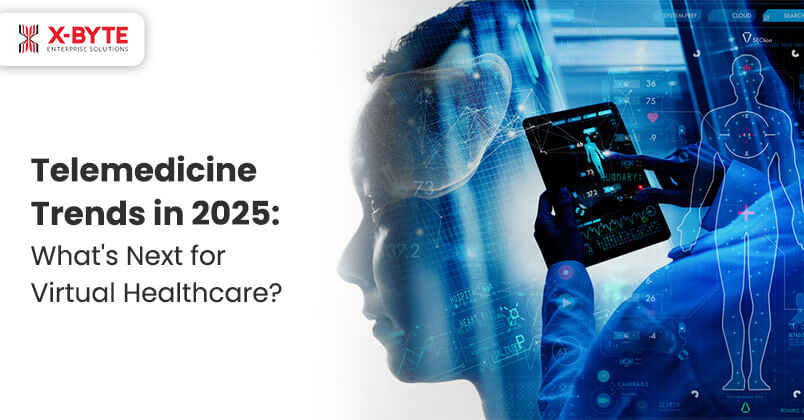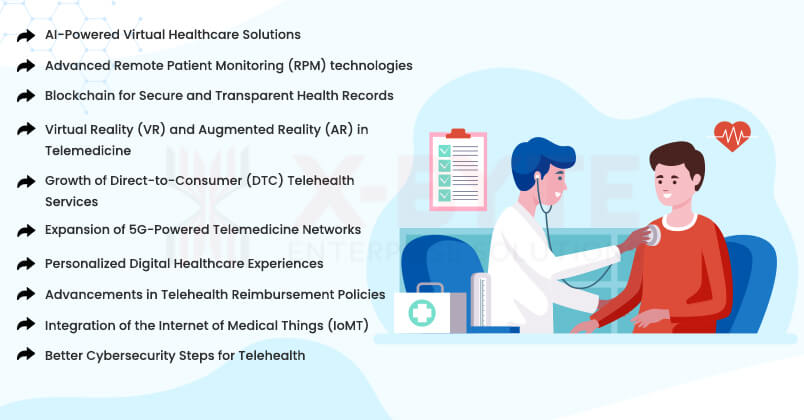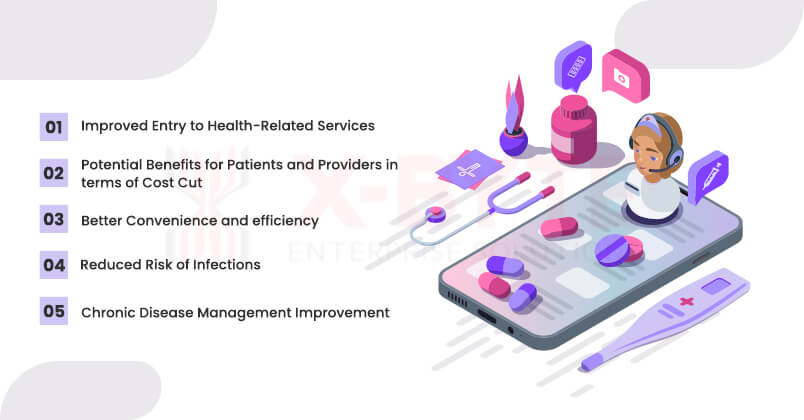-
solutinos
-
Hire
Frontend Developer
Backend Developer
-
NodeJS Developer
-
Java Developer
-
Django Developer
-
Spring Boot Developer
-
Python Developer
-
Golang Developer
-
Ruby on Rails Developer
-
Laravel Developer
-
.NET Developer
Technology
-
Flutter Developer
-
React Native Developer
-
Xamarin Developer
-
Kotlin Developer
-
Cross-Platform Developer
-
Swift Developer
-
MongoDB Developer
-
C Developer
-
Smart Contract Developers
Cloud
-
-
Services
Mobile Development
Web Development
- Work
-
Multi Services App
-
Food Delivery App
-
Grocery Delivery App
-
Taxi Cab Booking App
-
Multi Services App
-
OTT Platform APP
-
Social Media APP
-
Freelance Service App
-
Car Rental App
-
Medicine Delivery App
-
Liquor Delivery App
-
Sports Betting App
-
Online Coupon App
-
eLearning App
-
Logistics & Transportation App
-
Courier Delivery App
-
On-Demand Real Estate App
-
E-Wallet APP
-
Online Dating App
-
Handyman Services App
-
-
Process
-
Company

Quick Summary : Telemedicine is currently transforming the delivery of healthcare services by ensuring that the geographical location of patients and providers is not a hindrance. Due to recent improvements in telemedicine tech like medical IoT, telemedicine software, remote monitoring tools, etc., adding a telemedicine solution to conventional healthcare is now easier than before. The article discusses telemedicine trends in 2025, their importance, and how they will direct virtual healthcare's future.
Telemedicine is the virtual delivery of healthcare services–online patient checkups, remote monitoring of patient vitals with RPM devices, and keeping online medical records. From diagnosis to treatment, telemedicine is an online activity. The patient and the doctor are connected with telecommunication tech like video conferencing software. Virtual healthcare has received immense support from technological development across digital health, artificial intelligence, cloud, and mobile technology applications. Telemedicine app development services have helped healthcare givers to diagnose, treat, and even monitor their patients without even physically visiting them.
Experts further anticipate that telehealth’s most significant advancements will occur in 2025—diagnostics powered by artificial intelligence, patient records fully secured by blockchain technology, and virtual sessions facilitated by 5G networks. These technologies will improve performance and patient satisfaction, cost savings, and information security.
This article examines the latest trends in telemedicine, their benefits, real-world applications, and prospects.
What is Telemedicine? And How Does it Function?
Telemedicine is a concept of healthcare delivery implemented and facilitated with the use of telecommunications technology where a healthcare provider and a patient are geographically separated. This empowers doctors to diagnose, treat as well as keep watch on their clients, without having to visit facilities.
Today’s patients lack time and may have geographical restrictions, and hospitals may lack space to accommodate all patients at once. As a result, it has become a trend for patients to demand faster and more convenient methods of consultation.
On the other hand, providers seek to achieve better efficiency in their working process and address as many clients outside of hospitals or clinics as possible. It not only eliminates space issues but also increases the patient client base as now healthcare providers can serve even those who are situated in remote locations.
The surge in telemedicine software development occurred during the COVID-19 pandemic, proving its importance in continuing healthcare services.
According to market projections, the growth rate of the telemedicine market in the global economy is set to grow at a rate of 17.96% per year through 2030.
This expansion is due to factors like:
- Rising age of the population
- The growing demand for cheaper forms of healthcare
- Governments are getting more involved in adopting technology for the betterment of healthcare institutions
- Rising adoption of telemedicine by providers
- More openness of patients for virtual health consultations
- Lesser scrutiny by healthcare regulations
As traditional healthcare systems adopt telemedicine as a new normal for delivering services, virtual health is clear to be a long-term change that will define the future of healthcare.
Emerging Telemedicine Trends in 2025

Artificial intelligence, cloud computing, and mobile health IT drive telemedicine adoption and acceptance. By 2025, the major emerging technologies, including artificial telemedicine applications, blockchain security deployment, and 5 G integration, will be integrated within virtual healthcare.
The following sections discuss the major opportunities in telemedicine, further advances, and how these are transforming the global healthcare system.
AI-Powered Virtual Healthcare Solutions
Telemedicine is being advanced even further by AI, through utilizing integrated skills in carrying out medical procedures, optimizing diagnosis accuracy, and improving patients’ experiences. Telemedicine solutions that use AI have evolved to real-time disease detection, analysis of symptoms, and tailored treatment plans through large data sets.
These improvements make processes more productive, speed up diagnoses, and reduce the load on healthcare workers who deal with complex cases that need repeated steps.
AI integrated custom telehealth app can interact with patients, ask questions, help them through symptom-detection tools, and can also offer preliminary diagnoses before the interaction with the physician.
Advanced Remote Patient Monitoring (RPM) technologies
Remote patient monitoring has grown as wearable health gadgets and internet-connected medical tools have become more advanced. These devices can capture a patient's condition at a specific moment, giving doctors a chance to spot issues with long-term illnesses before they get worse. Some remote monitoring systems also use AI to alert medical staff when something unusual happens, helping them deal with cases that might need hospital care.
Blockchain for Secure and Transparent Health Records
Telemedicine's growth has pushed data protection and security forward. Blockchain helps tackle these issues. It creates health records that authorized doctors can access. Once entered, these records can't be changed. This builds trust, eases rule compliance, and lowers the risk of data breaches. If you want to create a telemedicine app integrated with blockchain tech, then hire a quality telemedicine app development company that offers apps that are compliant with medical regulations like HIPAA.
Want to benefit from the transformative potential of custom telemedicine solutions?
Hire our healthcare software developers!
Virtual Reality (VR) and Augmented Reality (AR) in Telemedicine
VR and AR technologies are playing a growing role in telemedicine platforms, creating lifelike and hands-on healthcare experiences. These tools prove valuable in mental health therapy, pain control, and recovery. VR settings, for example, help treat phobias through exposure therapy. AR aids doctors in showing complex medical steps or body parts during remote visits.
Growth of Direct-to-Consumer (DTC) Telehealth Services
The growth of DTC telehealth services has an impact on how patients and healthcare providers interact. These platforms give users quick access to doctors often through subscriptions or pay-per-visit options. While they make getting care easy and fast, they also bring up issues about ongoing care and its quality. Those who make rules and healthcare systems are trying to fit these services into wider care networks to make sure patients get full care.
Expansion of 5G-Powered Telemedicine Networks
5G tech is making telemedicine better. It allows for quick video calls and data sharing with little delay. This lets experts give real-time diagnoses from afar, do virtual surgeries, and share clear images for online check-ups. These changes make healthcare more available and useful. Custom telemedicine app development services make apps that are compatible with 5G telecommunication technology.
Personalized Digital Healthcare Experiences
It is considered that telemedicine platforms are shifting towards personalized patient care due to advancements in big data and AI. These platforms look at individual health histories genetic details, and eating habits to offer more precise treatment choices. This lets them suggest specific treatment plans and ways to prevent illness for patients with long-term health problems to manage their conditions better.
Advancements in Telehealth Reimbursement Policies
As telehealth becomes more common, payment policies are changing to back its expansion. Many of the short-term telehealth rules put in place during COVID-19 are under review to become permanent. This includes wider Medicare coverage for telehealth services and looser rules on practicing across state lines. Yet, hurdles still exist in creating a single approach to telehealth payment across different insurers and states.
Integration of the Internet of Medical Things (IoMT)
The Internet of Medical Things (IoMT) has a growing influence on telemedicine. This network of linked medical devices and software apps improves health data collection, analysis, and transmission. Smart pills that track how well patients take their meds and connected inhalers that watch usage trends allow IoMT to provide more thorough and ongoing patient care outside regular healthcare places.
Better Cybersecurity Steps for Telehealth
As telehealth platforms deal with more sensitive patient info, cybersecurity becomes a key concern. Experts apply advanced encryption methods, multi-step verification, and AI-powered threat-spotting systems to guard against data leaks and follow HIPAA rules. Healthcare groups also put money into staff training and regular security checks to keep telehealth services safe and private.
Advantages of Telemedicine

Telemedicine benefits patients, clinicians, and healthcare organizations collectively.
Below are the top advantages of telemedicine for the healthcare industry:
Improved Entry to Health-Related Services: Telemedicine's advantage in extending healthcare services to limited-access areas is clear. Considering the geographical aspect, patients no longer have to move to the healthcare provider’s place to seek consultation, which has made it easier.
Potential Benefits for Patients and Providers in terms of Cost Cut: Telemedicine reduces health bills because there is no need for transport, fewer hospitalizations, and fewer office expenses. Hospitals and care delivery organizations also safely reduce capital expenditures and avoid operational costs and a chance to reinvest in enhancing digital health services.
Better Convenience and efficiency: Clients can reach healthcare providers without leaving their homes, thus the waiting time within clinics and hospitals is reduced. From the healthcare providers’ perspective, telemedicine helps schedule and manage patients to optimize their process.
Reduced Risk of Infections: Telemedicine apps reduce the chances of the spread of infections between patients and healthcare professionals by decreasing direct physical visits. This was mainly recognizable during the COVID-19 pandemic when telehealth solutions played a very important role in maintaining healthcare continuity.
Chronic Disease Management Improvement: Daily checkups are very important for chronic disease patients. Telemedicine involves many virtual follow-up and remote patient supervision visits. It helps control diseases like diabetes, heart disease, and hypertension without going to the hospital regularly.

Take your medical practice online with custom telemedicine software development!
Get Quote Now! Get Quote Now!How Telemedicine Will Benefit the Healthcare System?
As telemedicine continues to evolve, it offers numerous benefits that extend beyond patient care, positively impacting the entire healthcare system.
Reduced Burden on Healthcare Facilities: Managing follow-ups of minor consultations online has helped to free up an enormous flow of patients in hospitals and clinics. This makes it possible for healthcare providers to organize their work strategically and address important cases.
Enhanced Preventive Care: Telemedicine also offers certain screening measures, health check-ups, counseling for mental health issues, and treatment of chronic conditions. This early intervention detects health complications and treats them before they become worse.
Improved Patient-Doctor Interaction: Telemedicine fosters stronger patient-doctor relationships by encouraging frequent consulting. Patients can follow up with their doctors more easily, which ensures better compliance with doctors’ advice and recommendations, leading to faster recovery.
Increased Workforce Efficiency: Doctors and other medical practitioners can effectively plan their time, serve more patients, and avoid numerous unnecessary physical interactions. This is a good thing for any healthcare process since efficiency is derived without compromising the quality of services.
Expansion of Healthcare Services: Telemedicine increases the accessibility of healthcare because it enables medical professionals to serve a vast number of patients including in regions that are rural and underdeveloped. Such expansion helps to provide the mass population with high-quality services for health needs.
Improved Monitoring with Integration with Wearable and AI Technologies: Telemedicine app development improves through the integration of wearable devices and artificial intelligence diagnostics. These technologies help obtain real-time patient information, enhancing the identification and recommendation of health conditions.
Comparison of Traditional Healthcare vs. Telemedicine
| Feature | Traditional Healthcare | Telemedicine |
|---|---|---|
| Reachability | Limited to physical locations | Remotely available |
| Cost-effectiveness | Cost is high for patients as well as providers | Reduces transportation, management, and operational expenses |
| Suitability | Need in-person visits | Access to doctors from any location |
| Diagnostic efficiency | Requires booked consultations | Fast access to healthcare providers |
| Transmission threat | Increased due to crowded facilities | Vey less risk with virtual visits |
| Chronic Care Management | Demands daily hospital checkups | Allows remote monitoring and management |
Comparison of the Healthcare System With and Without Telemedicine
| Aspect | Without Telemedicine | With Telemedicine |
|---|---|---|
| Hospital Overcrowding | High because of too many patient visits | Decreased due to remote medical visits |
| Follow-up Care | Restricted availability for patients | Regular and convenient follow-ups remotely |
| Healthcare Cost | Costly because of due to operational expenses | Less due to fewer in-person visits |
| Access to Specialists | Usually delayed because of availability | Instant access to healthcare via telemedicine |
| Preventive Care | Reduced emphasis on early intervention | Enhanced through regular online assessments |
Conclusion
Telemedicine is now a permanent fixture in the healthcare industry. Telemedicine plays a crucial role in current healthcare initiatives as it involves the tools for revolutionizing and improving access, productivity, and security to healthcare. Telehealth is bound to be even more efficient and effective once AI, blockchain, and 5G technology scale to their fullest potential.
The future success of telemedicine depends significantly on investments in technology, evolution in regulatory frameworks, and the security of data to facilitate business success. The advancement of virtual healthcare seems to have a bright future and the rise of telemedicine is set to a defining moment in 2025.
If you are looking to develop custom healthcare software solutions like telemedicine apps, then X-Byte can help you start your remote healthcare journey with comprehensive telemedicine software development services.
Get HIPAA-compliant telemedicine app development services from X-Byte’s healthcare software development experts now!
Frequently Asked Questions
-
What are the benefits of telemedicine?
The core benefits of telemedicine include increasing the availability and effectiveness of health care services, saving costs of treatment, the convenience of the procedure, increasing patient interest, and the ability to get away from crowding hospitals. It also uses trends such as Artificial Intelligence, blockchain, and remote patient monitoring to deliver proper healthcare solutions.
-
How secure is telemedicine in protecting
patient data?
Telemedicine software tools developed by professional software developers maintain high levels of data confidentiality due to increased investment in cybersecurity, such as the use of blockchain encryption and cloud-based storage. Technological giants applying blockchain techniques ensure secure storage of customers' medical records, eliminating the chances of data theft.
-
What are AI-powered virtual healthcare assistants, and how do
they help?
Virtual healthcare assistants are advanced algorithms commonly used to diagnose patients, examine their symptoms, and suggest courses of treatment. These assistants ease doctors' work by performing preliminary assessments that enhance timely and accurate decisions in the medical field.
-
What advancements does 5G technology bring to telemedicine?
5G technology promotes telemedicine because it provides internet connectivity at a much higher speed and with less delay. This makes it possible to have clear, quality video calls that include consultations, real telesurgery, and improved efficiency in the transmission of patient information between healthcare providers and patients.
-
What is RPM in the context of Telemedicine and how does it
function?
Remote Patient Monitoring (RPM) is the continuous monitoring of patient health status mainly through data collected from wearable devices and IoT. The metrics are also real-time, which allows the doctor to identify a health problem early and take appropriate measures.
-
How does telemedicine contribute to mental healthcare?
Telemedicine has greatly enhanced mental health, offering teletherapy, artificial intelligence for mental health, and CBT. It also maintains constant contact with licensed therapists, so people can access mental health services even without physically going to a therapist.
-
What are the challenges of telemedicine, and how can they be
addressed?
Despite its advantages, telemedicine has limitations, such as telemedicine legal frameworks, cybercrime, literacy in online communication, lack of equal access to an internet connection, and acknowledgment. These challenges can be reduced by applying strong standardized regulations, improving security protocols, and expanding 5G networks in underserved areas.
-
What is the future of telemedicine?
Artificial intelligence, the new generation of mobile connections, secure blockchain solutions, and wearable health devices will drive the next generation of virtual care. The industry is expected to become more integrated, smooth, individualized, and data-based healthcare provision across the globe.
